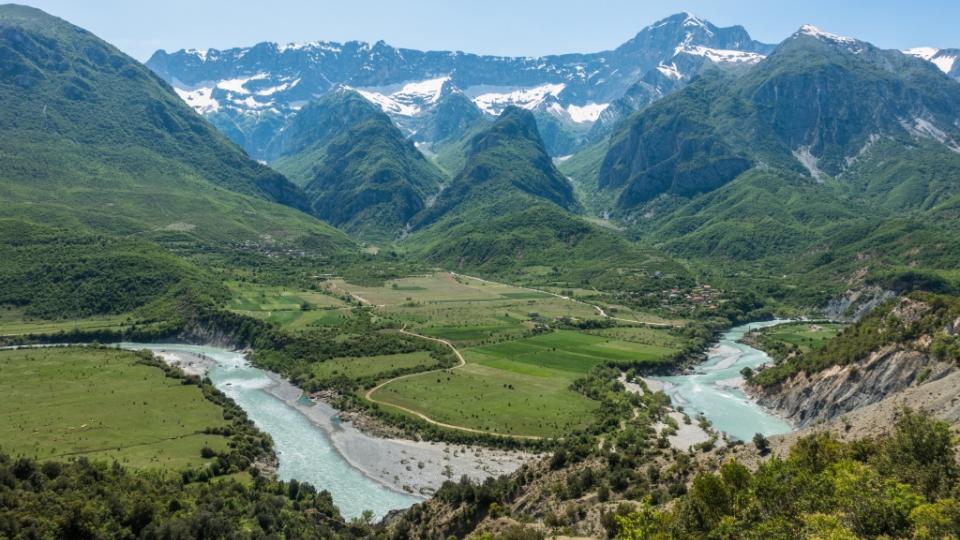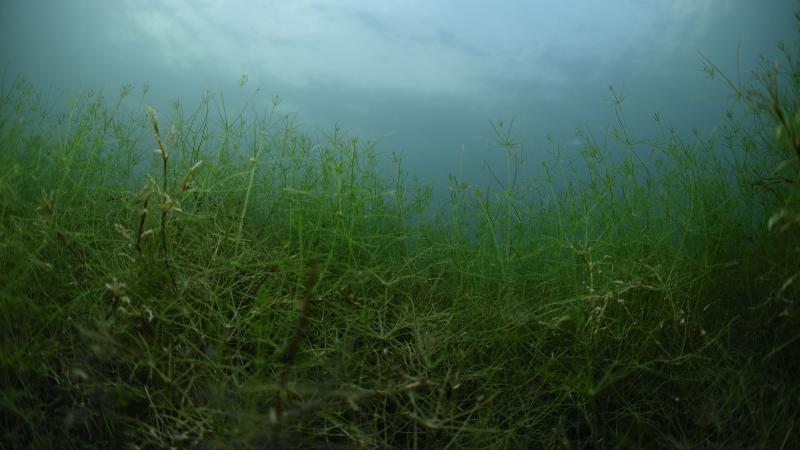
Water sampling and measurements of primary production at the Shushica, a tributary to the Vjosa far in the east, where snowmelt is long gone. The river is characterised by large boulders and crystal-clear water. | Photo: Lukas Thuile Bistarelli / IGB
The IGB research group Fluvial Ecosystem Ecology sampled the entire river network of the Vjosa in Albania in a three weeks long expedition. The team investigated the biodiversity of periphyton, bacteria and invertebrates, and measured a range of ecosystem functions ranging from enzyme activities to ecosystem-scale metabolism and evasion of greenhouse gases. The research efforts are part of the ERC-funded Starting Grant FLUFLUX, which aims to investigate linkages of biodiversity and ecosystem functions of whole river networks.
The Vjosa is a unique study place for this research question. For almost its entire course from the Greek Pindos mountains to the Adriatic Sea water flow and sediment transport are unobstructed, creating a dynamic river landscape that is not existing elsewhere at this spatial scale in Europe. Up to now the Vjosa is a hydromorphologically almost unaltered river, and as such an invaluable reference system to guide ecologists in future renaturation projects. Ideally, research findings of the team also contribute towards recognition of the Vjosa’s value and abandonment of current hydropower development plans.
The expedition was supported by scientists from the University of Natural Resources and Life Sciences in Vienna (BOKU), the Senckenberg Research Institute and Natural History Museum in Frankfurt, the Swiss Federal Institute of Aquatic Science and Technology in Zürich (Eawag) and the University of Tirana.
Sorting invertebrates in the field at the end of a long field day. | Photo: Gabriel Singer / IGB
Field measurements at the Upper Aoos in the Greek Pindos mountains. Boulders characterize the streambed. The water is clear and cold due to snowmelt in springtime. | Photo: Gabriel Singer / IGB
The Sarantaporos drains a catchment dominated by easily eroding sandstone. Its channel is dominated by gravel surfaces throughout its entire course. The river is one of the three main tributaries forming the Vjosa near the Greek-Albanian border. | Photo: Gabriel Singer / IGB
Measuring concentrations of greenhouse gases near Kalivac, the site for a projected dam. The picture shows only one of three channels of the river in a partially more than one kilometer wide gravel-dominated and highly dynamic river landscape. | Photo: Gabriel Singer / IGB
The Aoos downstream of Konitsa, where it leaves the Pindos mountains and turns into a braided river for the first time. The high amounts of transported sediment force braiding and enable a river landscape that has become rare elsewhere in Europe. | Photo: Gabriel Singer / IGB
The confluence of the Sarantaporos and the Aoos rivers at the Greek-Albanian border is the birthplace for the Vjosa. The widely differing catchment geology creates two very different rivers, whose flow and turbidity dynamics create the Vjosa’s color for the next 200 kilometer. | Photo: Gabriel Singer / IGB
Doing a measurement of carbon dioxide evasion with a drifting chamber from kayak. In the background the construction site of a 70 meters high dam near Kalivac. The disastrous ecological consequences of building this dam are clear, but if this should be the case, then the team´s measurements of greenhouse gas evasion are the baseline against which future data can be compared. | Photo: Gabriel Singer / IGB

Near the town of Tepelena the Drinos enters the Vjosa from the right. The team specifically targeted confluences for sampling work to capture differentiation of water chemistry and communities related to the river network´s topology. | Photo: Gabriel Singer / IGB

An upstream section of the Vjosa in Albania near the town of Permet, where the river follows a rather constrained river channel surrounded by mountains. Sampling and measuring work was partly achieved by boat. | Photo: Lukas Thuile Bistarelli / IGB




